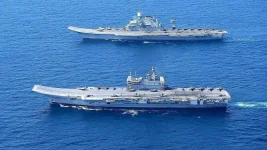- Views: 2K
- Replies: 24
India is making a significant change in its naval strategy, prioritizing the development of nuclear-powered attack submarines (SSNs) over the acquisition of more aircraft carriers.
This shift, confirmed by reports that the Ministry of Defence (MoD) has paused plans for a third aircraft carrier, underscores a focus on bolstering undersea warfare capabilities.
Experts, including Dr. Elizabeth Buchanan, a Senior Fellow at the Australian Strategic Policy Institute (ASPI), view this decision as a "major doctrinal shift." It represents a re-evaluation of India's strategic needs, with a growing emphasis on undersea warfare as a powerful deterrent against regional threats.
This prioritization of SSNs is in line with evolving global maritime strategies. Unlike aircraft carriers, which need considerable logistical support and are becoming easier to target with new missile technologies, nuclear-powered attack submarines can stay submerged for extended periods, travel at high speeds, and remain undetected. These features make SSNs exceptionally effective for projecting power and controlling access to key waterways.
The Indo-Pacific region's security landscape, particularly the increasing naval presence of China, is a key factor driving India's strategic shift. China's navy already operates a sizable fleet of nuclear-powered submarines, including both attack submarines (like the Shang-class) and ballistic missile submarines (like the Jin-class).
According to the US Department of Defense's 2023 report on Military and Security Developments Involving the People's Republic of China, the PLAN (People's Liberation Army Navy) is expected to continue growing its submarine force. India's focus on its own SSN program is viewed as a necessary step to ensure a strong underwater deterrent and safeguard its maritime interests.
The Indian Navy has historically considered the relative merits of aircraft carriers versus an advanced submarine force. Aircraft Carriers are very useful for the projection of force and providing air dominance, however, SSNs offer advantages such as stealth, unlimited range, due to nuclear power, and the element of surprise. The decision to concentrate on SSNs indicates a move towards a more indirect, or asymmetric, approach to naval warfare.
Currently, the Indian Navy operates two aircraft carriers, the INS Vikramaditya and INS Vikrant. India's first domestically built carrier, INS Vikrant, was officially put into service in 2022. Plans for a third carrier, which was to be named INS Vishal, have been shelved as resources are redirected to the SSN program.
This decision aslso supports India's larger goal of boosting domestic defence production, as the SSN project involves close cooperation between the DRDO and leading Indian shipbuilding companies. The DRDO's Submarine Design Bureau is the primary agency responsible for the indigenous SSN design.

